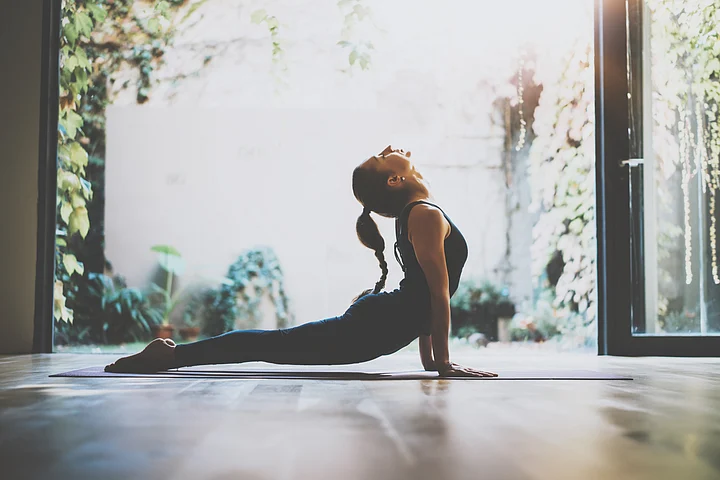Yoga is considered beneficial and effective in managing and preventing various health conditions. Yoga carries benefits for your overall health and well-being. It helps balance your energy, increases flexibility, and relieves stress.
According to PubMed, there is a connection between stress and hypothyroidism, and practicing certain yoga poses can help balance out thyroids that are either underactive or overactive.
Research has shown that yoga has a positive effect on improving thyroid function. The only thing you need to remember is that these yoga poses cannot be the cure for your thyroid problems but can be practiced as complementary therapy. You shouldn't practice yoga as replacement therapy for medications or treatments that you’re currently undergoing.
Here are a few common poses you can try, but consult a doctor and contact a yoga trainer for guidance.
Shoulder Support Headstand
A shoulder stand is one of the first poses that a trainer might ask you to try if you suffer from thyroid problems. It’s an inversion pose and that is why it stimulates blood flow to the glands of the upper body. It is believed that this yoga pose has a positive effect on the efficiency of the thyroid. Your chin tucked into your chest for this yoga pose is believed to benefit thyroid function.
You can try this at home by bending your elbows and placing your hands on your lower back in such a way that your fingertips point up toward the ceiling. Place your elbows on the ground, shoulder-width apart. Make sure your elbows do not splay out to the sides. When you get comfortable, slowly lift your thighs in a vertical position while keeping your knees bent.
Plough Pose
If you want to try the plough pose. Follow the steps given here:
Press your arms to the floor, and lift your legs over your head towards the floor while inhaling. You will have to stretch out through the heels. Now slowly walk your shoulders towards each other while your chin is up and hands are placed on the lower back for support. Press through the arms, shoulders, and feet if they are on the floor.
This yoga pose helps in stretching the neck, thus stimulating the thyroid glands. It also prevents and relieves tightness in the neck, shoulders, and back. The pose helps strengthen the shoulders, arms, and legs, and enhances flexibility, improves muscle and joint mobility. It also makes the spine more supple to help ease muscle tension and improve posture.
Cat-Cow Pose
The cat-cow pose is suggested for maintaining thyroid health because the fluid motion in this pose is believed to stimulate the thyroid glands. Drawing your chin into your chest and exposing your throat chakra improves blood flow in this area.
For this pose, you will have to kneel on the floor and place your hands on the floor in front of you. Make sure your hands are shoulder-width apart and your knees are below your hips. Inhale deeply and curve your lower back while you bring your head up, tilting your pelvis up like a "cow." Exhale deeply and bring your abdomen in, arch your spine, and bring your head and pelvis down like a "cat."
Boat Pose
The position of your neck during Boat Pose has a positive effect on the thyroid glands in the human body. It helps:
Tone the muscles of the abdomen
Strengthen the lower back
Opens the chest and engages the core muscles
Strengthens the hip flexors and adductor muscles
Stretches the hamstrings
Alleviate tightness in the hamstrings
To practice this pose, you will have to sit on the floor and extend your legs in front of you. Place your hands on the floor beside you, and let your upper body lean back slightly. Make sure your spine is straight and your chin is tucked in toward your chest.
Slowly try to balance on your two sitting bones and tailbone. Bend your knees before you lift your legs in the air and straighten your legs.
Lift your arms parallel to the floor and hold the backs of your thighs or let your hands rest on the floor. Engage your core and keep your breathing deep and relaxed. Hold the pose for a minute and then slowly release the pose.
Camel Pose
Camel Pose helps the front body stretch out and the parts include the chest, abdomen, and quadriceps. It also improves spinal mobility and doing a backbend may help you develop better posture. Practice the pose like this:
Come to your knees and place your legs hip-width apart. Keep your hips over your knees, squeeze your thighs toward each other, and inhale while you engage your belly. Then reach your tailbone toward your knees and create a space between your lower vertebrae.
Inhale again while you lift your sternum and draw your elbows back, toward each other behind you. Let the ribcage expand. The chest should be raised, core engaged, and chin tucked in. Press the heels of your hands into the heels of your feet while you drape the fingers over the soles. Lift your shoulders and let the trapezius muscles between the shoulder blades rise up and cushion the cervical spine. Extend the head and neck backward.
(At The Quint, we question everything. Play an active role in shaping our journalism by becoming a member today.)
